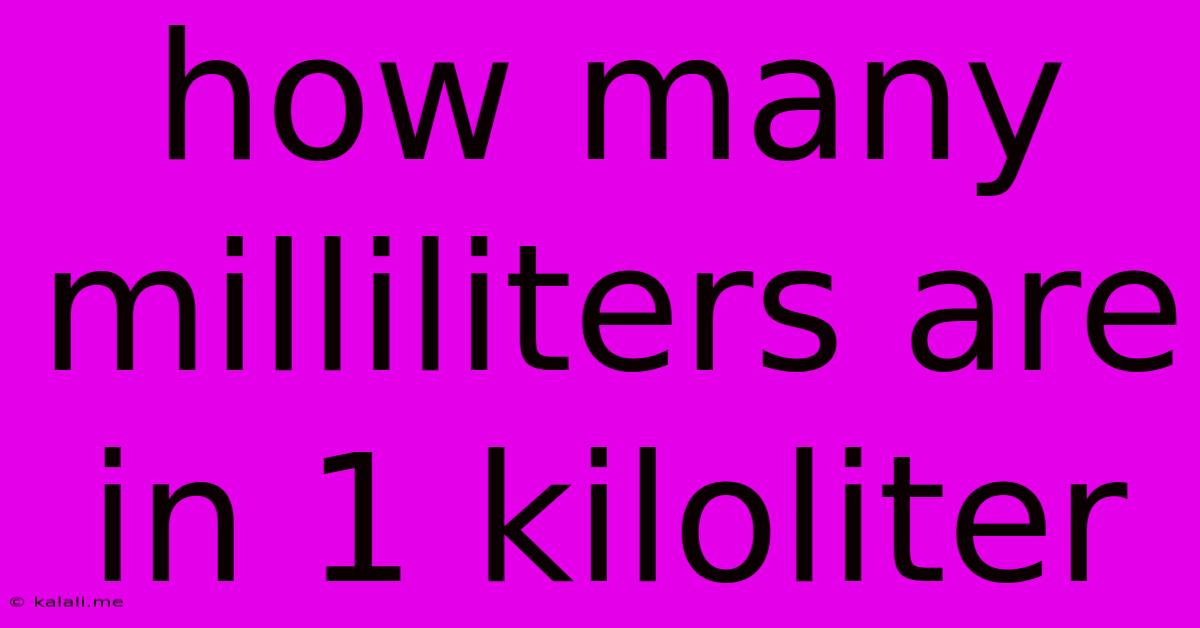How Many Milliliters Are In 1 Kiloliter
Kalali
Jun 14, 2025 · 2 min read

Table of Contents
How Many Milliliters are in 1 Kiloliter? A Comprehensive Guide
Knowing the relationship between milliliters (mL) and kiloliters (kL) is crucial for various applications, from cooking and chemistry to engineering and environmental science. This article will clearly explain the conversion, provide practical examples, and offer some helpful tips for remembering this essential metric conversion.
Understanding Metric Prefixes: The Key to Conversion
The metric system is based on powers of 10, making conversions relatively straightforward. The prefixes "milli" and "kilo" are key to understanding this conversion. "Milli" (m) means one-thousandth (1/1000), while "kilo" (k) means one thousand (1000). Therefore, a kiloliter is 1000 liters, and a milliliter is 1/1000 of a liter.
The Conversion: From Kiloliters to Milliliters
To convert kiloliters to milliliters, we need to consider the relationship between liters, kiloliters, and milliliters:
- 1 kiloliter (kL) = 1000 liters (L)
- 1 liter (L) = 1000 milliliters (mL)
Therefore, to find out how many milliliters are in 1 kiloliter, we multiply:
1 kL * 1000 L/kL * 1000 mL/L = 1,000,000 mL
There are 1,000,000 milliliters in 1 kiloliter.
Practical Applications and Examples
Understanding this conversion is useful in numerous scenarios:
- Chemistry and Laboratory Work: Calculating the volume of solutions or reagents. For instance, a chemist might need to prepare 0.5 kL of a specific solution, and knowing the conversion is crucial for accurate measurement.
- Environmental Science: Measuring water flow in rivers or rainfall amounts. Large volumes of water are often measured in kiloliters, while smaller samples for analysis might be measured in milliliters.
- Engineering: Designing and calibrating equipment that handles large volumes of liquids, such as industrial water tanks or fuel storage systems.
- Everyday Life: While less common, it's useful to understand the relationship for situations involving large quantities of liquids. Imagine calculating the volume of water needed to fill a very large swimming pool.
Tips and Tricks for Remembering the Conversion
- Think in powers of 10: The metric system is beautifully simple because it utilizes powers of 10. Remembering that "kilo" means 1000 and "milli" means 1/1000 makes the conversion much easier.
- Visualize: Imagine a large container (1 kL) being filled with smaller containers (1 mL). This visual representation helps solidify the concept.
- Practice: Work through a few conversion problems. This practice will reinforce your understanding and improve your ability to quickly calculate these conversions.
This comprehensive guide provides a clear and concise explanation of how to convert kiloliters to milliliters. Understanding this fundamental metric conversion is essential for various fields and can help in tackling problems involving large and small volumes of liquids. By mastering this simple conversion, you'll enhance your understanding of the metric system and improve your problem-solving skills across numerous applications.
Latest Posts
Latest Posts
-
Which Country Borders The Most Nations Mongolia Germany Brazil Luxembourg
Jun 15, 2025
-
During A Chemical Reaction The Number Of Atoms
Jun 15, 2025
-
Which Of The Following Is A Push Factor
Jun 15, 2025
-
Greatest Common Factor Of 64 And 96
Jun 15, 2025
-
Which Feature Defines A Neutral Atom
Jun 15, 2025
Related Post
Thank you for visiting our website which covers about How Many Milliliters Are In 1 Kiloliter . We hope the information provided has been useful to you. Feel free to contact us if you have any questions or need further assistance. See you next time and don't miss to bookmark.